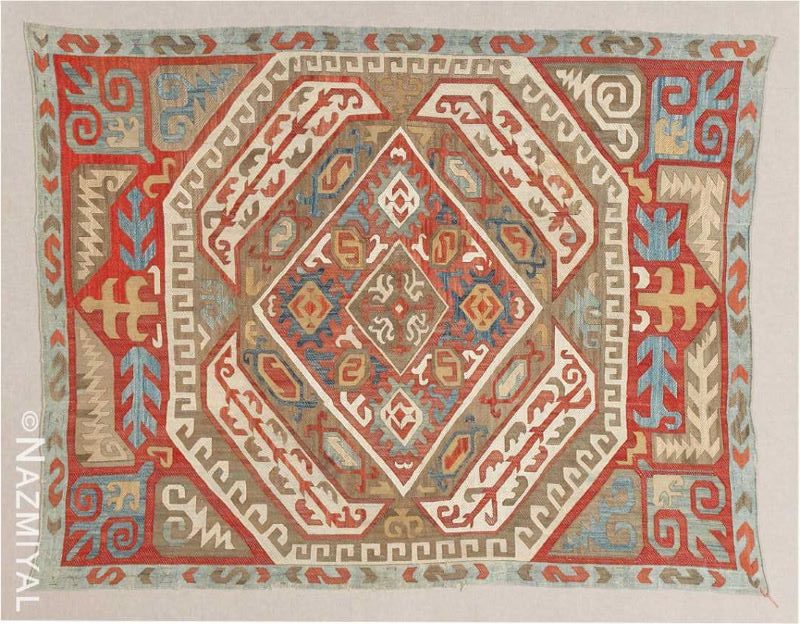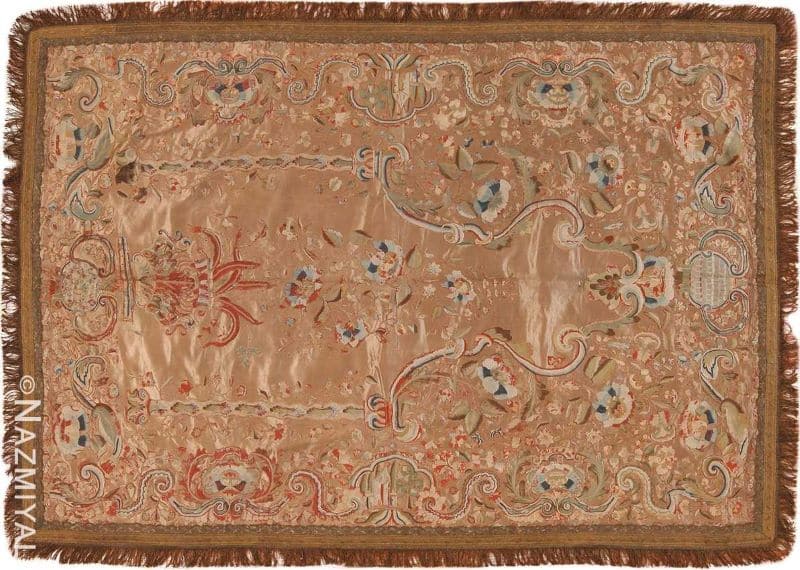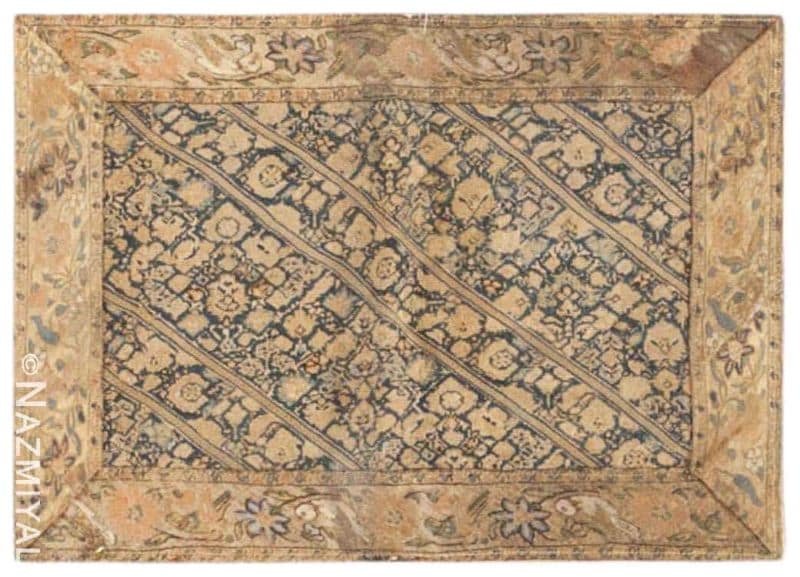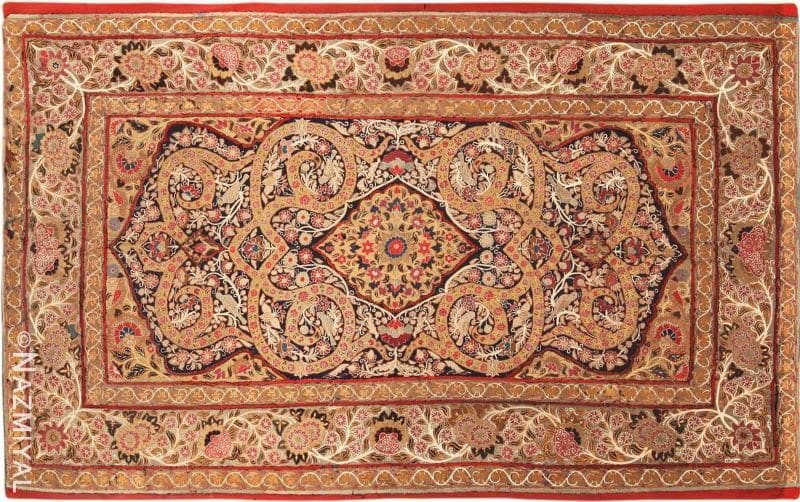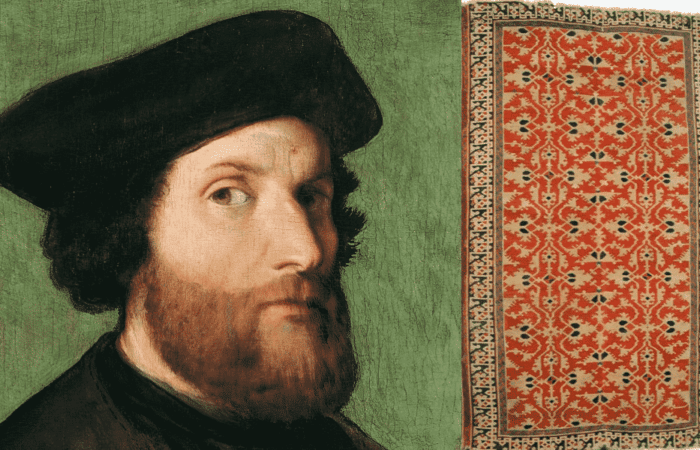Antique Byzantine Art Textiles and Weaving Symbolized the Wealth of the Empire
What Was The Byzantine Empire?
The Byzantine Empire, also known as the Eastern Roman Empire, was a continuation of the Roman Empire in its eastern regions after the fall of the Western Roman Empire. It emerged in the 4th century CE and lasted until the 15th century CE. The Byzantine Empire was centered around the capital city of Constantinople (present-day Istanbul), which was founded by the Roman Emperor Constantine the Great in 330 CE.
The Byzantine Empire experienced significant cultural, political, and religious developments. It was a predominantly Greek-speaking society and inherited many aspects of Roman law, government, and administration. The empire’s legal system, known as Corpus Juris Civilis or Justinian’s Code, had a profound influence on subsequent legal systems in Europe.
The Byzantine Empire faced numerous challenges throughout its existence, including invasions by various barbarian groups, conflicts with the Persian Empire, and clashes with Islamic forces during the Arab expansion. Despite these challenges, the Byzantine Empire managed to survive and even flourish during certain periods.
One of the most notable emperors of the Byzantine Empire was Justinian I (reigned 527-565 CE). His reign is known for the reconquest of large parts of the former Western Roman Empire, including North Africa and Italy. Justinian’s reign also witnessed a significant codification of Roman law, known as Justinian’s Code, which had a lasting impact on legal systems.
The Byzantine Empire played a crucial role in preserving and transmitting classical knowledge and literature to the medieval West. Byzantine scholars and theologians made important contributions to philosophy, science, and theology. Additionally, the Byzantine Empire was a center of religious life, with the Eastern Orthodox Church being the predominant Christian denomination.
The empire gradually declined in the face of various internal and external pressures. The Fourth Crusade in 1204 dealt a severe blow to Byzantium, leading to the establishment of a Latin Empire in Constantinople for a short period. Although the Byzantines managed to reclaim Constantinople in 1261, the empire was greatly weakened. The final blow came in 1453 when the Ottoman Turks, led by Mehmed the Conqueror, captured Constantinople, bringing an end to the Byzantine Empire.

Byzantine Textile Art
What Is The Definition of “Byzantine”?
“Byzantine” refers to the Byzantine Empire, which was the eastern continuation of the Roman Empire that existed from the 4th century CE until its fall in 1453 CE. The Byzantine Empire was centered around the capital city of Constantinople (modern-day Istanbul) and played a significant role in shaping the history, culture, and politics of Eastern Europe, the Balkans, and the Middle East.
The Byzantine Empire, or Byzantium, consisted of the remnants of the Roman Empire after the fall in the 5th Century AD. The Byzantine Empire continued to exist for another thousand years until it would later fall to the Ottoman Turkish Empire in 1453. Throughout its history, the Byzantine Empire achieved a high level of art and culture that would have an impact on the civilizations that followed. Traces of Byzantine art can still be found in the artwork of the Ottoman Empire and others. Among these works of art, their skill and advancement of the Byzantine textile arts is one of their most notable contributions to global culture.
Here are two common Byzantine definitions:
- Relating to Byzantium or the Byzantine Empire: Byzantine refers to the Byzantine Empire, which was the Eastern Roman Empire that existed from the 4th century to the 15th century. It was centered around the capital city of Constantinople (present-day Istanbul). The term can be used to describe anything related to this historical period, including its art, architecture, culture, politics, or history.
- Complex, intricate, or devious: Byzantine can also be used as an adjective to describe something that is excessively complicated, intricate, or convoluted, often implying a sense of unnecessary complexity. It can also refer to a system or process that is excessively bureaucratic or involves excessive formalities and red tape. In this sense, it can be used to describe a situation, organization, or process that is difficult to understand, navigate, or deal with.
It’s worth noting that the second Byzantine definition is derived from the perception of Byzantine bureaucracy during the Byzantine Empire’s later years. These were characterized by complex administrative systems and intricate court rituals.
What is Byzantine art?
Byzantine art refers to the artistic style that emerged in the Byzantine Empire during the Late Antiquity and Middle Ages. It encompasses various forms of visual arts, including architecture, mosaics, paintings, icons, and manuscript illumination. Byzantine art is deeply rooted in the traditions of Roman, Greek, and early Christian art but also incorporates distinctive elements that reflect the empire’s religious, political, and cultural characteristics.
Key features of Byzantine art include:
- Religious Focus: Byzantine art primarily served religious purposes, with a strong emphasis on the Eastern Orthodox Christianity practiced in the Byzantine Empire. The artworks aimed to convey religious teachings and evoke a sense of divine presence.
- Iconography: Byzantine art extensively employed symbolic and stylized representations of religious figures, particularly Christ, the Virgin Mary, and various saints. These images, known as icons, were believed to possess spiritual power and were venerated in religious rituals.
- Mosaics and Frescoes: Byzantine artists extensively used mosaics and frescoes to adorn churches, palaces, and public buildings. Mosaics, composed of small colored glass or stone pieces, were intricate and highly detailed, often covering large areas. Frescoes, paintings done on wet plaster, adorned the walls and ceilings of buildings.
- Flat Perspective: Byzantine art employed a distinctive style of representation that favored a flat and symbolic approach over naturalistic rendering. Figures often appeared frontally, with stylized proportions and minimized depth to convey spiritual rather than physical reality.
- Use of Gold: Gold was a prominent feature in Byzantine art, symbolizing divine light and transcendence. Gold leaf was applied to backgrounds, halos, and clothing to create a shimmering effect and indicate the heavenly realm.
- Architectural Splendor: Byzantine architecture is characterized by structures such as the Hagia Sophia in Constantinople, featuring domes, pendentives, and elaborate ornamentation. The architecture aimed to create a sense of grandeur and spirituality.
Byzantine art had a lasting impact on later artistic traditions, particularly in the Eastern Orthodox world and its influence extended to regions such as Russia, the Balkans, and the Middle East. It is renowned for its rich symbolism, spiritual depth, and the preservation of classical heritage within a distinct Eastern Christian context.
The Church and Byzantine Art
Many of the surviving examples of Byzantine art is of religious nature, particularly those displaying iconography. The images of saints and important people were carefully controlled and standardized by the Christian Church. Byzantine artwork spread throughout the world and included art and architecture in Italy, Egypt, Arabia, Russia, Romania, and many places in between. Few pieces of Byzantine textiles have survived through the years, but we can understand their high level of development by examining miniatures and paintings of the time.
Antique Artistic Byzantine Textiles
It is easy to see from these paintings that Byzantine art textiles were in vibrant colors, with a preference for reds and blues. They also used bright oranges and purples. This shows a highly developed control of the dye processes and procedures. At that time, all of these brilliant colors would have been created using only plant dyes.
Currently, one of the largest collections of Byzantine art textiles in the world is housed in the Byzantine and Christian Museum in Athens, Greece. This museum has about 1,000 antique textile pieces dating from the 5th to the 12th centuries. From this collection, we can learn quite a bit about Byzantine textiles. One of the things that stands out the most about this collection is the level of fine detail and advanced textile weaving techniques that were used, particularly in objects intended to be used for religious purposes.
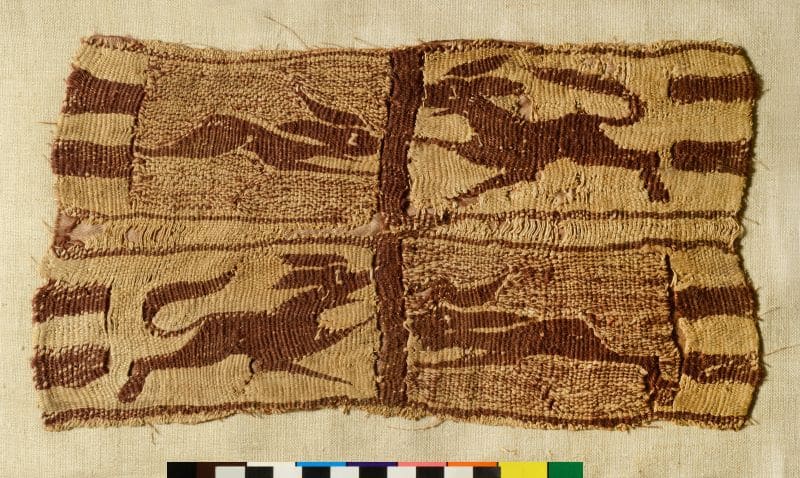
A fragment of a textile probably cut from the sleeve of a tunic, from the 4th-6th century.
Antique Textiles in Byzantine Constantinople
Constantinople, in Anatolia, was seated at the crossroads of the Middle East, Asia, and Europe. As such, it was home to one of the most extensive trade networks in the world. The Byzantines of Constantinople became extremely wealthy, and they dressed to show off their success. Visitors often commented about the finery of the clothing worn by the populous. They were made from the finest silks, in purple, and laden with gold threads. These were typically reserved for royalty elsewhere, but it seems that in Constantinople, this was more common street attire.
The textile arts were one of the most respected crafts to the Byzantines. They were considered high art, just as much as painting, sculpture, and architecture. Many of the textiles followed the standards set forth to control the other arts by the Byzantine Church, which would later become the Greek Orthodox Church. For the most part, the body of existing textiles are those used by the Church for special occasions, rather than those worn for everyday purposes.
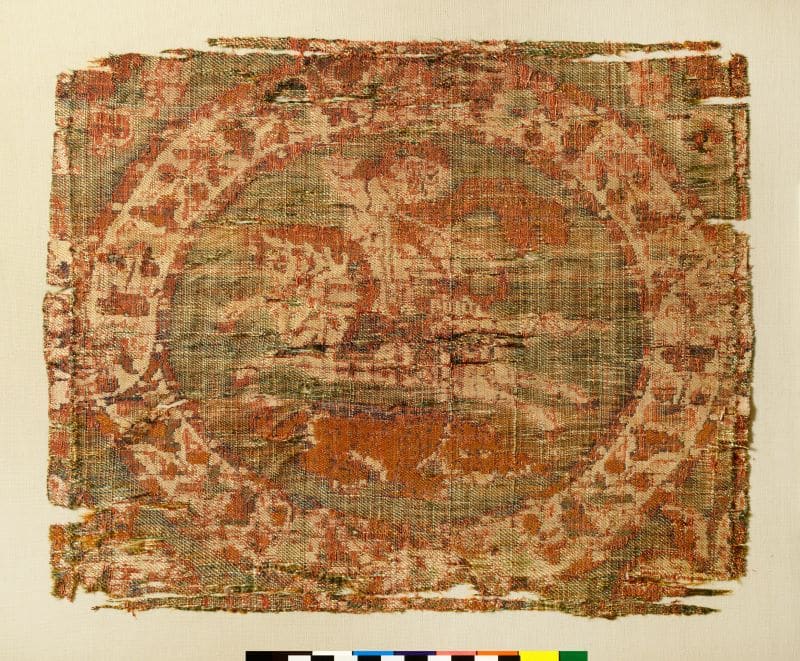
A colorful silk textile fragment.
Byzantine Silk
In the early part of the Empire, China had strict control over silk production. The Byzantines had to purchase silk from the Chinese. However, in the 6th century AD, the Byzantines acquired the secret of silk production. The story goes that a group of monks was sent to smuggle silkworm eggs out of China. By the 7th century, they had mastered the production techniques to the point where they no longer had to import silk from the Chinese. Many of the finest silk textile examples that have survived, were woven in intricate patterns and then embroidered with gold thread.
The silk industry in Constantinople was divided into five highly specialized guilds.
They were the:
The weavers held a place of high status in Byzantine society. It is thought that cheaper Syrian silks were intended for the populace and that true Byzantine silk was reserved for royalty. It had been mentioned that there were 2,500 Jewish dyers in Byzantine Pera, to give you an idea of the size of the industry.
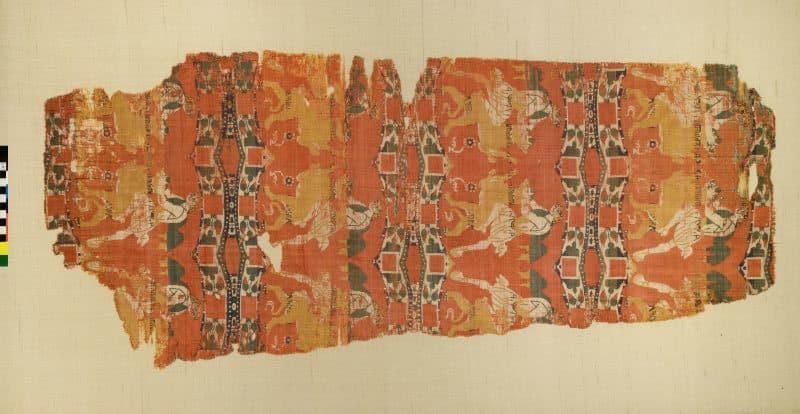
“The Hero and the Lion” silk textile, circa 7th-9th century.
Byzantine Rugs
Much of the attention of academic scholars has been placed on textiles used for clothing. However, equally spectacular rugs were produced, too. The rugs that adorned palaces and the homes of the people were used to show status and wealth.
Byzantine rugs show similar border designs and colors as Islamic rugs of the time. Bright reds and blues were the dominant colors, much as they are today. Border designs of Byzantine rugs included florals, plant motifs, vines, and leaves. The centers often represented people and events. Sometimes, these rugs were hung on walls and used as tapestries to provide decoration and insulation.
These beautiful works of Byzantine art show the expert knowledge and craftsmanship of the weavers. Often, they combined wool, cotton, silk, and gold threads into a single piece. Textile art helped to define the wealth and power of the Byzantine Empire. You can find the roots of Islamic and Persian design in the borders and patterns of the rugs. The Byzantine textiles and rugs that still exist are a world treasure from one of the greatest Empires in history.
Here are some beautiful, rare and collectible antique textiles from the Nazmiyal Collection:
This rug blog about Byzantine art and textiles was published by Nazmiyal Antique Rugs.

